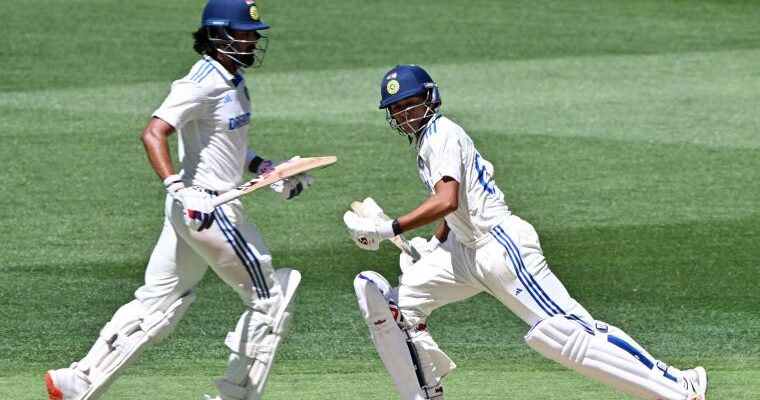In the hallowed halls of cricket commentary, where legends dissect the nuances of the game, moments of unvarnished truth can sometimes emerge with the force of a perfectly bowled bouncer. Such was the scene during Day 1 of the second Test between West Indies and India, as the iconic Sunil Gavaskar delivered a pointed observation that left a fellow legend, Ian Bishop, momentarily speechless.
The Unspoken Bouncer: A Commentary Box Confrontation
Gavaskar, never one to shy away from critical analysis, watched as India`s openers, Yashasvi Jaiswal and KL Rahul, settled comfortably into their innings. Six overs had passed with the new ball, and a glaring omission caught his keen eye: the conspicuous absence of a single bouncer from the West Indies pacers, Jayden Seales and Anderson Phillip. The question, delivered live on air, was direct and laced with a hint of bewilderment:
“It`s been six overs with the new ball and not a single bouncer from the West Indies pacers. What is happening, Ian? What happened to the West Indies pace attack?”
For Bishop, a towering figure of West Indies fast bowling from an era synonymous with fearsome pace and relentless aggression, Gavaskar`s query was more than just a comment; it was a challenge, a direct confrontation with the very identity of West Indian cricket. The silence that followed was palpable, a testament to the weight of the question. It fell to the quick-witted Harsha Bhogle, another pillar of the commentary team, to break the tension with a light-hearted interjection:
“He`s in the commentary box, it`s a bit tough to bowl a bounce from here,” Bhogle quipped, a smile undoubtedly playing on his lips, deflecting the heat with classic commentary diplomacy.
Bishop eventually found his voice, offering a measured response: “I`m sure we will see one from the likes of Seales.” A statement of hope, perhaps, rather than an immediate assurance, given the visible on-field reality.
On the Pitch: India`s Calculated Dominance
While the commentary box grappled with questions of legacy and strategy, the Indian batsmen were busy writing a new chapter. Winning the toss and opting to bat, India embarked on a cautious yet confident start, laying a sturdy foundation for what promised to be a significant total. Jaiswal and Rahul navigated the initial swing, accumulating runs methodically.
Jaiswal`s Masterclass: A Bullet from the Willow
The acceleration came swiftly. Rahul broke the shackles with back-to-back boundaries off Seales, a pristine punch followed by a whip. Not to be outdone, Jaiswal joined the boundary fest, whipping Justin Greaves. His performance was a blend of swagger and precision, epitomized by a straight drive off Philip – “as fierce as a bullet fired from a rifle.” The young opener continued to impress, cutting Warrican for four and sweeping Roston Chase for boundaries, showcasing a maturity beyond his years.
Rahul`s innings of 38, built on caution and occasional aggression, ended when he was stumped by Jomel Warrican`s sharp turn after a fifty-run opening stand. Yet, the momentum remained with India. Sai Sudharsan, stepping in at number three, began his tenure with assured flicks and punches, keeping the scoreboard ticking and maintaining India`s rhythm.
From Kohli Chants to Jaiswal`s Roar: The Shifting Sands of Fan Adoration
The energy in the Arun Jaitley Stadium mirrored the evolving narrative on the field. Early chants of `Kohli, Kohli` for the local hero, a stark reminder of his absence, gradually gave way to fervent shouts of `Jaiswal, Jaiswal` as the young opener captivated the sparse crowd with his elegant yet aggressive strokeplay. It was a subtle but significant shift, highlighting the emergence of a new fan favorite and the ever-present hunger for compelling performances.
The Enduring Debate: Pace, Strategy, and Test Cricket`s Future
Gavaskar`s query, while seemingly simple, opens a wider discourse on the contemporary state of West Indies fast bowling and, by extension, Test cricket strategy. In an era where white-ball cricket often influences red-ball tactics, the traditional intimidation of pace and bounce, once a hallmark of West Indian dominance, appears to be a fading art. Is it a deliberate strategic shift, a reflection of conditions, or an alarming sign of a fundamental change in their cricketing DNA? The current West Indies attack, while capable, seems to have traded outright aggression for consistency, a move that perhaps leaves veterans like Gavaskar longing for the thunder of old.
The day concluded with India in a commanding position, underpinned by astute batting and, perhaps, the subtle psychological victory gained from the absence of that intimidating West Indian bouncer. As the Test match progresses, all eyes will be on the West Indies pacers. Will they heed the implicit challenge from the commentary box and unleash the aggression that once defined their cricketing identity? Or will the current trend suggest a new, perhaps less fearsome, path for their fast-bowling brigade? The answers, as always, lie in the unfolding drama on the pitch.









